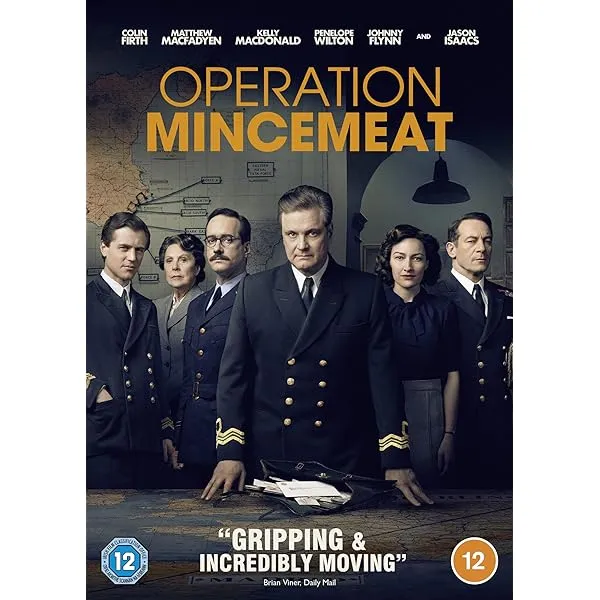Historical accuracy of Operation Mincemeat

Historical accuracy of Operation Mincemeat

Characters
Ewen Montagu
Montagu was a real naval intelligence officer who led Operation Mincemeat. His crucial role is accurately shown, but the film adds a fictional romantic subplot involving Jean Leslie.
Charles Cholmondeley
Cholmondeley was a real officer key to conceiving the operation. The film accurately portrays his contribution but invents a romantic rivalry with Montagu over Jean Leslie for drama.
Jean Leslie
Jean Leslie was a real MI5 secretary whose photo was used for the fake fiancée "Pam". The film fictionalizes her personal life (as a widow) and adds a central love triangle subplot.
Ian Fleming
Fleming worked in naval intelligence under Godfrey and contributed to the Trout Memo that inspired the plan. His direct operational role and narrative function may be embellished.
Hester Leggett
Based on the real Hester Leggatt, head of the MI5 secretarial section credited with writing the crucial fake love letters. Her portrayal reflects her known historical role.
Admiral John Godfrey
Godfrey was the actual Director of Naval Intelligence and Ian Fleming's superior. His position of authority and oversight is accurately depicted.
More characters
Bentley Purchase
Purchase was the real coroner who obtained the corpse of Glyndwr Michael, a vital and accurately portrayed contribution to the operation.
Glyndwr Michael / Major Martin
Glyndwr Michael was the real Welsh homeless man whose body was given the identity of Major Martin. The film accurately reflects this central historical fact.
Joan Saunders
Represents the vital work of female secretaries in MI5; likely a composite character or possibly based loosely on individuals like Iris Michelmore involved in the operation's details.
Ivor Montagu
Ivor Montagu was Ewen's real brother, whose known communist sympathies posed a real security concern during the war, a tension accurately included in the film.
Colonel David Ainsworth
This character represents the real and crucial role of the British Naval Attaché in Spain (likely Capt. Alan Hillgarth), who handled the situation locally after the body was found.
Winston Churchill
Churchill was the British Prime Minister; his portrayal reflects his leadership position and awareness of significant intelligence operations like Mincemeat.
Story
The core concept of Operation Mincemeat
The core plot of using a deceased body with false documents to mislead the Axis powers is historically accurate. Operation Mincemeat was a real and audacious deception operation.
The creation of 'Major William Martin'
The fictional identity of Major William Martin, including his backstory and personal effects, was a crucial part of the deception and is accurately represented.
The dropping of the body off the coast of Spain
The method of delivering the body to the Spanish coast via submarine and allowing it to wash ashore is a factual element of the operation.
The role of the Spanish authorities
The film depicts the Spanish authorities' involvement in recovering the body and the documents. While the general interaction is accurate, some details of their investigation and communication with the British are fictionalized.
The Allied intelligence's assessment of the operation's success
The film portrays the Allies' assessment of the operation's success in diverting Axis attention from the Sicily invasion. While the overall impact is considered significant, the film simplifies the complexities of evaluating the deception's effectiveness.
The romantic subplot involving Montagu and Jean Leslie
The film includes a romantic subplot between Montagu and Jean Leslie, which is loosely based on their real-life acquaintance. However, the extent and nature of their relationship is unknown.
The depiction of the post-mortem examination
The film shows aspects of the post-mortem examination of the body used in the operation. While details may be dramatized, the general procedure and purpose are likely based on forensic practices of the time.
The portrayal of the German Abwehr
The film depicts the German Abwehr's reaction to the information from 'Major Martin.' While they were indeed deceived, the film simplifies the complexities of their intelligence analysis and their ultimate conclusions.
The film's pacing and dramatic license
While the film adheres to the main facts of the operation, it takes some dramatic license with the pacing, the dialogue, and the emotional dynamics of the characters to create a more compelling cinematic experience.
Setting
The portrayal of the intelligence community
The film depicts the atmosphere and workings of the British intelligence community during the war. While some aspects are accurate, others are simplified or embellished for cinematic effect.
The depiction of the war context
The film accurately portrays the broader context of World War II and the strategic importance of the Sicily invasion. The backdrop of the war is well-integrated into the narrative.
The ethical considerations of the operation
The film touches upon the ethical considerations of using a deceased person in a deception operation, which is a valid point of discussion surrounding the real event.
The level of secrecy surrounding the operation
The film emphasizes the high level of secrecy surrounding Operation Mincemeat, which is historically accurate. The operation was kept confidential for many years after the war.
The use of historical documents and photographs
The film incorporates historical documents and photographs, which adds to the authenticity of the narrative and underscores the real-world basis of the story.
